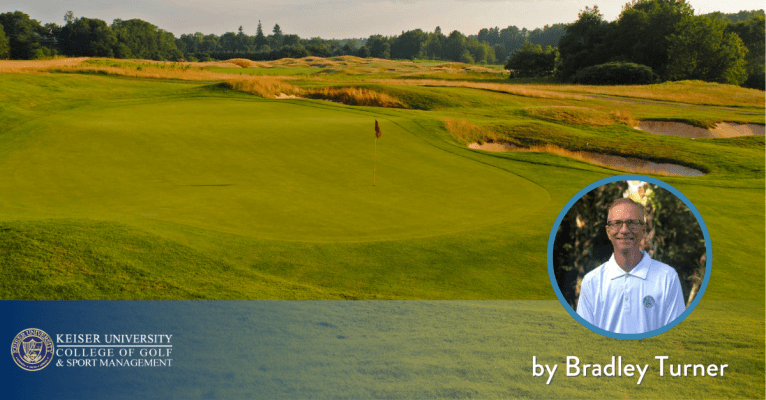13 Types of Grass and How They Affect Your Golf Game

by Bradley Turner, Keiser University College of Golf Director of Online Golf Instruction – PGA, MBA
In 1991, I moved to Orlando from the Midwest, where I had lived most of my life in Michigan, Ohio, and Indiana. I had spent a few winters in Florida prior to moving to Orlando, but I had never experienced a Florida summer. I learned through trial and error (a lot of error, for sure) how to play out of the different grass conditions. Let me share some of my experiences in playing on different types of grasses. This article will highlight the difference between northern and southern grasses, along with some advice on playing from them. You can learn more about the types of grass with our Turfgrass Management degree program.
What Type of Grass is Used on a Golf Course?
Knowing the type of grass you’re playing on can give you a strategic edge. How can you identify the type of grass on the course?
- Start by checking the blade texture. Bentgrass, for example, feels soft and fine, while Bermudagrass has a coarser, more wiry feel.
- Color is another giveaway—cool-season grasses like Ryegrass and Fescue stay a lush green in spring and fall, while warm-season types like Bermuda or Zoysia shine in the heat of summer.
- If you’re chipping around the green and notice the grain pulling your ball a certain way, that’s a strong sign you’re on Bermudagrass. Got rough areas with thin, wiry blades and wispy tufts? You’re likely dealing with Fescue.
- Don’t forget to ask the pro shop—most staff know exactly what’s growing under your spikes.
- Once you learn to read the grass, you’ll start adjusting your game like the pros do.
Northern Grasses
As you might expect, northern grasses evolved to withstand low temperatures but are susceptible to problems with high temperatures and high humidity. There are numerous varieties of each of the grass types listed below. For example, some bentgrass strains are best suited for the New England area of the country, while other strains work best in the Midwest. The science of turfgrass continues to evolve, enabling golf course superintendents to provide ideal playing conditions almost anywhere in the country.
Bentgrass
Many of the best private clubs have bentgrass greens and fairways. This turf provides ideal putting green conditions if the goal is fast, championship-type putting surfaces. The grass can withstand lower mowing heights, so fairways can be cut very short, making it more difficult for the average golfer to strike a ball solidly off the fairway. Augusta National, located in the southern state of Georgia, has bentgrass greens. Augusta National also has a sub-air system that can irrigate the greens and keep them cool during the hot summer months. The greens are mowed 365 days a year and are cared for like a newborn baby. If Augusta wants bentgrass greens well, you know that bentgrass must be the best!
Creeping Bentgrass
Creeping Bentgrass is a cool-season grass renowned for its fine texture and dense growth. It requires a lot of maintenance, making it a preferred choice for putting greens in cooler climates. Its ability to be mowed very short allows for smooth, fast greens, enhancing the precision of putts. Golfers will appreciate the consistent ball roll on Bentgrass greens but must adapt to its firmness and speed.
Kentucky Bluegrass
This is a common grass used at golf facilities with tight budgets and must manage maintenance costs. Less costly to maintain than bentgrass, this grass cannot withstand lower mowing heights resulting in a bit longer and fluffier fairway condition. Many average to higher handicap golfers prefer bluegrass since the ball can rest off the ground a bit more than with bentgrass. Lower handicap golfers do not like bluegrass as much since there is more potential for grass to get between the ball and the clubface. This results in a “flyer” where the ball will travel farther than expected from those fluffy lies in the fairway. Bluegrass is used for fairways and rough areas on the golf course but is not a preferred grass for putting surfaces.
Ryegrass
This grass is found in temperate climates as it does not tolerate prolonged drought or high or low temperatures. This does not seem to be an ideal grass for golf courses! However, ryegrass is used in the southern regions to overseed golf courses for the winter months. Golf course grasses in the south will go dormant in the winter months as temperatures drop. Ryegrass is usually seeded in October or early November and will produce beautiful green golf course conditions. The heat of late spring will eventually burn out the winter ryegrass as the bermudagrasses of the south spring back to life. Augusta National over seeds their fairways and rough areas with ryegrass, and we know how good that looks during the Masters telecast.
Poa Annua Grass
Known as a weed at golf courses due to its invasive nature, poa is found all over the world. Many golf courses in the northern region with bentgrass greens must contend with the inevitable invasion of poa. This occurs during late spring when the poa plant produces small seed heads for about three weeks. Golfers track these seeds from their shoes onto the next golf course they play! It can be a green superintendent nightmare trying to manage this grass. Golf courses with a blend of bentgrass and poa will eventually create problems for golfers since the poa grass will grow a bit faster than bentgrass over the course of a day. This results in bumpy putting surfaces and frustrated golfers! Once the greens are mowed the following morning, the putting surfaces can be excellent until later in the day when the poa seedlings begin to show. This will last for a short period of time in the golf season but can be disappointing to the golfer when well-struck putts are deflected offline.
There are some famous golf courses with putting greens that are 100% poa. Oakmont Country Club greens are over a century old and are considered some of the finest putting surfaces in the world. Pebble Beach and Olympic Club are also completely poa on the greens. A pretty amazing weed, in my opinion!
Fescue
Fescue grass is drought-tolerant and require less maintenance. The wispy appearance can add aesthetic value to courses makes them suitable for roughs and naturalized areas. Balls landing in Fescue may be difficult to locate and extract, demanding precise shot-making and strategic play.
Tall Fescue
Tall Fescue is a cool-season grass that provides drought resistance and durability. Golfers may experience that Tall Fescue provides a more stable lie when used in fairways and roughs. However, the thicker grass blades can slow down clubhead speed, affecting shot distance and accuracy.
Fine Fescue
Fine Fescues, including Creeping Red, Chewings, and Hard Fescues, are known for their fine blades and shade tolerance. While they provide a firm playing surface, their low wear tolerance means they are less suited for high-traffic areas. Golfers will appreciate the tight lies Fine Fescues offer, which can facilitate clean ball striking, especially in links-style courses.
Southern Grasses
Research and development have significantly improved golf course conditions in the southern states. Historically, the finest conditioned golf courses were up north, where bentgrass is king. However, the golf course conditions in the south today at higher-end facilities are absolutely comparable with the best of the northern states.
Bermudagrass
This is the most widely used grass on golf courses in the southern states as this grass thrives in warm climates. Common bermudagrasses are dense grass with a coarse texture used for fairway and rough areas. Hybrid bermudagrasses have been developed that allow for extremely fast putting surfaces, yet the grass can tolerate higher temperatures.
Bermudagrass rough is much more difficult to play from than northern grass rough. The coarse blades of grass combined with a root structure called stolons that rest on top of the soil make it challenging for golfers to make solid contact. Stolons are thick roots that help spread the growth of the grass. When you are in the rough, the stolons and coarse blades make it very difficult to advance the ball from bermudagrass rough. Even the best players in the world will struggle to play from deep bermudagrass rough. As for short game shots, I do not know of any professional player that prefers to play from bermudagrass due to the presence of grain and the thick nature of the blades of grass. When you struggle with the short game while vacationing in Florida, remember that it is not you; it’s the grass!
Hybrid Bermudagrass
Hybrid Bermudagrass is a warm-season grass that thrives in southern climates. The durability and quick recovery from divots make this type of grass a favorite for high-traffic areas. However, bermudagrass demands consistent maintenance to keep its aggressive growth in check. The grain of Bermudagrass can influence ball behavior, requiring golfers to adjust their techniques accordingly.
Paspalum
A recent strain of southern grass that tolerates high salt levels in the soil of seaside golf courses is paspalum. The new strains of paspalum are similar to bermudagrass and provide excellent putting surfaces since the grass can withstand lower mowing heights. More seaside golf courses in Florida are opting for this grass due to the excellent playing conditions and the tolerance of salt-water invasion. Playing conditions are similar to bermudagrass, so do your best to stay in the short grass.
Zoysiagrass
The transition zone for growing a thriving grass is an area of the country where northern grasses have a difficult time tolerating the summer heat and humidity, while the southern grasses struggle in the winter months due to potentially extreme cold temperatures. The Mason-Dixon line is a good reference point for the heart of the transition zone.
Zoysiagrass is a wonderful grass for many golfers due to the dense and thick nature of the blades of grass. This allows the ball to sit up nicely in the fairway and around the green complex. The one negative most golfers experience with Zoysiagrass is the sticky bounces on short game approach shots. It is not recommended to play bump and run type shots around the green as the thick blades of grass will quickly stop a ball from its momentum to the flagstick!
Diamond Zoysiagrass is a new hybrid strain that is being used on putting surfaces. If mown down to a low height, this type of grass provides excellent putting conditions and tolerates high levels of golf traffic. However, greens can be very slow and sticky if they are not mowed down properly, making it frustrating for most golfers to adjust to the slow speeds.
In review, remember that grasses on golf courses are not the same, so you may find yourself hitting unexpected golf shots. The only way to become proficient in playing on the variety of grasses on golf courses is to play a wide variety of golf courses!
St. Augustine Grass
St. Augustine Grass is a warm-season turf known for its broad blades and lush appearance. It thrives in humid coastal regions and is often used in roughs and residential lawns. Its dense growth can create challenging lies, as the thick blades may interfere with club movement. Golfers may need to adjust their swing to account for the resistance St. Augustine Grass can present during shots.
In review, remember that grasses on golf courses are not the same, so you may find yourself hitting unexpected golf shots. The only way to become proficient in playing on the variety of grasses on golf courses is to play a wide variety of golf courses!
Learn more!
Want more tips? If you want to take your game to the next level, contact our team at Keiser University’s College of Golf & Sport Management today. With our dedication and experience, together, we can elevate your game to new heights. Give us a call today at 888-355-4465.















Thanks for this post, it’s enlightening and adds to my understanding of why the highlighting of the various strains of grasses on TV. I will certainly pay closer attention to the course location and it’s grass types in the future
Great synopsis! Thanks, I used to live up in Chicago area and our club had bent grass greens and I loved putting on them.
I’ve always loved being around golf courses because of their beauty and tranquility. Last year I bought an 18 hole 99 year old golf club. Bentgrass greens. It needs some TLC it has some Zoysia fairways but alot of wide variety grasses. It is in northern KY what do you recommend ?